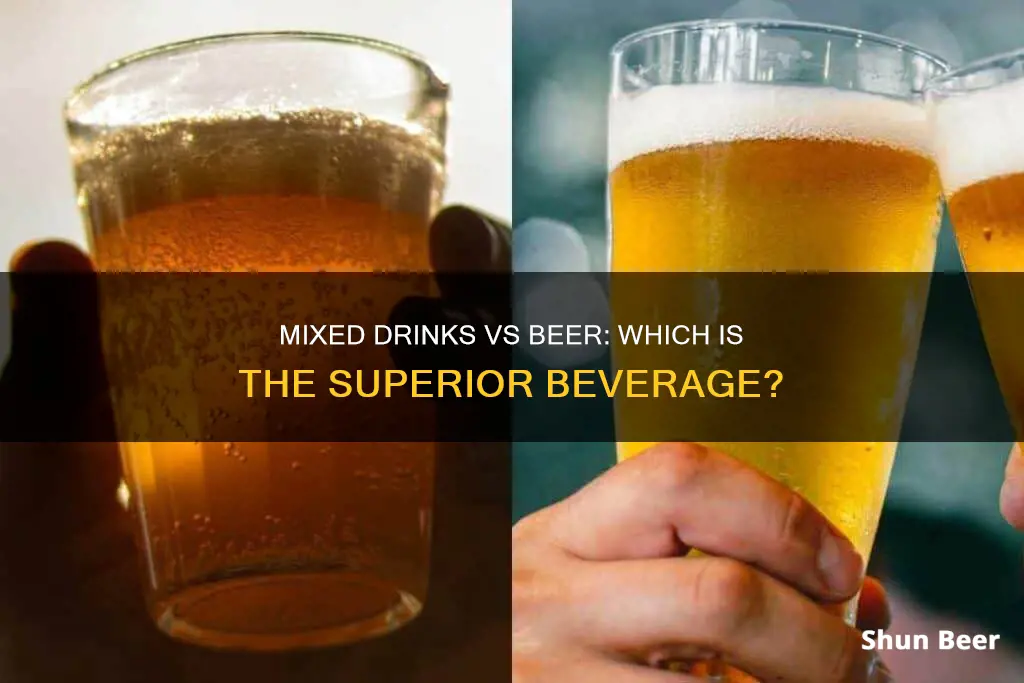
When it comes to choosing between mixed drinks and beer, there are several factors to consider. Both drinks have their pros and cons, and the best choice for an individual may vary depending on their preferences and drinking habits. Beer is generally seen as a more social drink, and it can be easier to pace yourself when drinking beer as it is typically consumed in larger quantities. Mixed drinks, on the other hand, tend to have a higher alcohol content and can be easier to consume in larger quantities, leading to a higher risk of overconsumption. In terms of health, beer has more antioxidants than mixed drinks, but mixed drinks often have fewer or no carbohydrates. Ultimately, the choice between mixed drinks and beer depends on personal preferences, and it is important to drink in moderation to avoid negative health consequences.
What You'll Learn

Beer has more calories than spirits
The calorie content of alcoholic beverages can vary significantly, and it's important to consider the impact of drinking on weight management and overall health. Alcoholic drinks are often high in calories and provide little to no nutritional value. A night of drinking can easily add 500 or more calories to your daily intake.
Spirits, also known as liquor, include drinks such as vodka, gin, rum, and tequila. According to the Dietary Guidelines for Americans, a serving of spirits is considered 1.5 fluid ounces of an 80-proof liquor. For 100-proof spirits, the serving size is 1 fluid ounce. These servings will provide around 100 calories.
On the other hand, beer calories can vary depending on the type and brand. "Light" beers typically range from 90 to 100 calories per 12-ounce serving, while some beers can top out at around 300 calories. Regular beer typically falls in the range of 150 to 300 calories per 12-fluid ounces.
It's worth noting that the mixers used in cocktails can significantly increase the calorie count. Sugary mixers, regular soda, or juice can add hundreds of extra calories to a drink. Therefore, when comparing beer to spirits, it's important to consider not only the base spirit but also any additional ingredients that may be used.
Beer Left Out: Is It Still Safe to Drink?
You may want to see also

Beer has more antioxidants than spirits
Polyphenols, the most abundant dietary antioxidants, are present in all fruits and vegetables. Beer, coffee, chocolate, tea, and wine are significant sources of these antioxidants, with beer containing about 30% of hop-derived polyphenols and the remaining 70% from malt. The addition of certain foods during the fermentation process, such as walnut, chestnut, cocoa, honey, green tea, coffee, and licorice, can significantly increase the polyphenol content and, thus, the antioxidant activity of beer.
The phenolic profile of beer includes phenolic acids, flavonoids, and stilbenes, with ferulic acid being the most abundant phenolic acid in conventional beers. The specific antioxidants in beer differ from those in wine because the barley and hops used in beer production contain different flavonoids from those in grapes used for wine.
Beer's high antioxidant activity and phenolic content are essential factors in determining its nutritional quality and offer several health benefits, including a reduced risk of cardiovascular disease, cancer, diabetes, inflammation, and degenerative diseases.
Beer and Metronidazole: Is It Safe to Mix?
You may want to see also

Beer is harder to binge drink than spirits
Liquor or spirits, such as vodka, gin, rum, and tequila, are considered "hard" alcohol. They have a higher alcohol content than beer, with liquor's alcohol by volume (ABV) ranging from 40-50%, compared to beer's 4-6% ABV. This means that consuming the same volume of beer and liquor will result in different levels of intoxication, with liquor leading to quicker and more intense intoxication.
A standard serving of beer is typically 12 fluid ounces, while a serving of liquor is usually 1.5 fluid ounces, often in the form of a shot. Despite the smaller serving size of liquor, the higher alcohol concentration can lead to a quicker and more severe intoxication. This makes it easier to accidentally consume more alcohol than intended when drinking spirits.
Beer drinkers often consume larger volumes than those who drink liquor. Social and cultural norms also play a role, with beer commonly consumed in social settings like bars and parties, and liquor frequently consumed in smaller amounts or mixed into cocktails. The higher alcohol content of liquor can also make it easier to mask the strong flavor with non-alcoholic mixers, potentially leading to over-consumption.
Binge drinking is defined as consuming enough alcohol to reach the legal limit for driving, which is about five drinks for men or four for women in less than two hours. Binge drinking can lead to serious health issues, including alcohol poisoning, liver disease, and an increased risk of accidents and injuries. It is more common with liquor due to its higher potency, but excessive beer consumption can also have similar risks.
Therefore, while both beer and liquor can be abused and lead to detrimental health effects, the higher alcohol content of liquor makes it harder to pace oneself and easier to accidentally binge drink.
Neoprene Beer Coolers: How Do They Work?
You may want to see also

Spirits are easier to over-pour than beer
Liquor is used to make a variety of cocktails, and this is where calories can get out of control. Mixed drinks have the highest potential for going calorically astronomical. Spirits are often mixed with sugary sodas or juices, which can result in a drink with 500 or more calories. It's also easier to over-pour a serving of liquor, unless you use a jigger to measure. A serving of 80-proof liquor like rum or vodka is 1.5 fluid ounces, while a serving of 100-proof spirits is 1 fluid ounce.
Beer, on the other hand, typically comes in set serving sizes, such as a 12-fluid ounce bottle or a 16-fluid ounce pint. While the calorie count can vary depending on the type of beer, it is generally easier to control your intake with beer than with spirits.
In addition, beer has some nutritional benefits that liquor does not have. A 2011 study published in the Journal of the Science of Food and Agriculture found that dark beers have more iron than both pale and non-alcoholic beers. Beer also has more antioxidants than hard liquor, although the overall effect is small.
So, if you're looking to control your calorie intake and get some added nutritional benefits, beer may be the better choice over spirits. However, it's important to remember that excessive alcohol consumption, regardless of the type, can lead to detrimental health effects.
Beer Drinking: A Daily Habit That Can Kill You
You may want to see also

Spirits have fewer or no carbohydrates
Spirits, such as whiskey, vodka, brandy, gin, and tequila, contain zero carbohydrates and are, therefore, a better option than beer if you are watching your carbohydrate intake.
A standard 12-ounce serving of 5% ABV beer usually has around 150 calories and 13 grams of carbohydrates. In contrast, a standard 1.5-ounce serving of spirits contains about 100 calories and zero carbs. However, when spirits are mixed with sweetened mixers, such as tonic water, juice, or soda, the carbohydrate and calorie content can increase significantly. For example, a gin and tonic can have up to 16 grams of carbohydrates, while a rum and Coke can contain 22 grams of carbohydrates.
If you are looking for low-carb alcoholic beverages, spirits like whiskey, vodka, and gin are a better choice than beer. Beer is typically high in carbohydrates, with a 12-ounce bottle containing anywhere from 2.6 to 14 grams of carbs. Even light beers, which are designed to have fewer calories and carbohydrates, can still contain up to 5.9 grams of carbs per 12-ounce bottle.
While spirits have fewer or no carbohydrates, it is important to remember that alcohol itself contains calories. Each gram of alcohol has seven calories, and these calories can contribute to weight gain, especially when consumed in excess. Therefore, whether you choose spirits or beer, it is important to consume alcohol in moderation.
Beer and Cephalexin: A Safe Mix?
You may want to see also
Frequently asked questions
It depends on your preferences and what you're looking for in a drink. Mixed drinks tend to have more calories than beer, but beer contains more carbohydrates. Beer also has more antioxidants than hard liquor, but the overall effect is small.
Mixed drinks offer more variety in terms of flavours and ingredients. They can also be made with diet mixers, sodas, or juices to reduce the calorie count.
Beer is generally easier to control calories with, as it's typically served in standardized servings. Mixed drinks can vary widely in their alcohol and calorie content, depending on the type of liquor and mixers used.
Drinking alcohol in moderation can offer some health benefits, such as reducing the risk of heart disease, stroke, or diabetes. However, excessive alcohol consumption can lead to detrimental effects, including liver damage and an increased risk of certain cancers.
If you're looking for a low-calorie option, wine or liquor on its own are good choices. Liquor, such as vodka, gin, rum, whiskey, or tequila, has zero carbohydrates and around 100 calories per serving.







